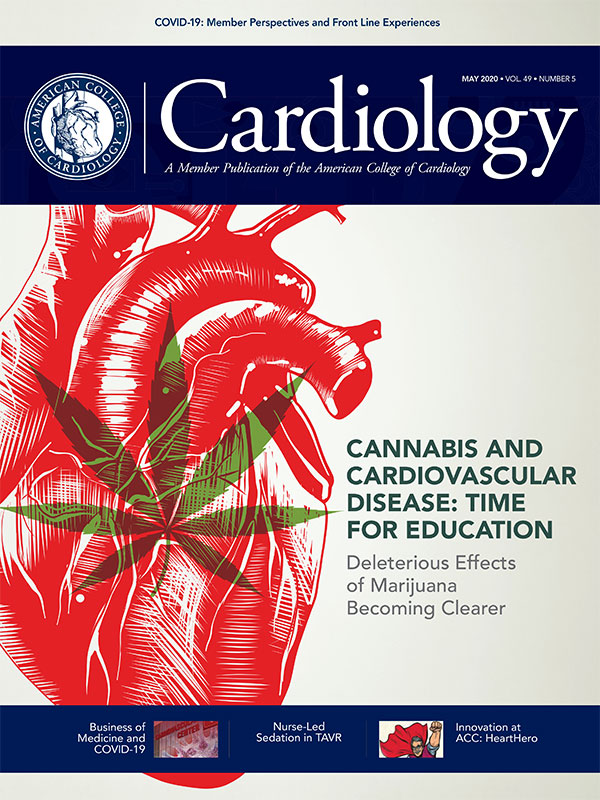Journal Wrap | Are Smartphone Camera Applications Accurate For Diagnosing AFib?
The hottest research from various peer-reviewed journals – handpicked weekly by the ACC.org Editorial Board led by Kim A. Eagle, MD, MACC.
Vascular Damage Similar With E-cigarettes, Traditional Cigarettes

Young adults using e-cigarettes exhibited arterial stiffness and blood vessel damage similar with those who smoke traditional cigarettes, according to a cross-sectional study published in the Journal of the American Heart Association.
As part of the Cardiovascular Injury due to Tobacco Use study, Jessica L. Fetterman, PhD, and colleagues studied more than 400 men and women, ages 21 to 45 years, who had not been diagnosed with heart disease or heart disease risk factors and were former traditional cigarette smokers.
Study participants included 94 nonsmokers, 285 cigarette smokers, 36 e-cigarette users and 52 dual users who smoked combustible cigarettes and used e-cigarettes. Combustible cigarette smokers and dual users were older than nonsmokers and e-cigarette users, while e-cigarette users were more likely to be younger, male and white.
Former smokers who switched to e-cigarettes and dual users had an augmentation index similar with traditional cigarette users, indicating their arteries were just as stiff, researchers found. Furthermore, endothelial cells appeared to be equally as damaged, producing less nitric oxide suggestive of impaired eNOS signaling, whether the participants used e-cigarettes, combustible cigarettes or both.
"In conclusion, our study provides new insights into the effects of tobacco product use on measures of vascular function in young, healthy adult individuals without cardiovascular disease risk factors," write the authors. They note the most recent nationally representative sample shows the majority of adult e-cigarette users are either former (36.5%) or current (22.1%) combustible cigarette smokers, emphasizing the importance of understanding cardiovascular health measures in these groups.
While most e-cigarette users switch to them because they think they are healthier, this study reveals there is no evidence that using e-cigarettes reduces the cardiovascular injury associated with the use of combustible tobacco products. Longitudinal studies are needed to evaluate the long-term risks of sustained e-cigarette use.
Fetterman JL, Keith RJ, Palmisano JN, et al. J Am Heart Assoc 2020;9(9):e014570.
Are Smartphone Camera Applications Accurate For Diagnosing AFib?

Jack W. O'Sullivan, MBBS, DPhil, et al., analyzed 10 primary diagnostic accuracy studies to determine the precision of smartphone camera applications that diagnose AFib. Sensitivity and specificity were measured with a bivariate random-effects meta-analysis. To simulate the use of these applications as a screening tool, the positive predictive value and negative predictive value for different population groups were modeled.
Out of the 10 primary diagnostic accuracy studies, 3,852 participants and four applications were included. The applications analyzed the pulse wave signal for a mean of two minutes.
Results showed that the sensitivity and specificity for all applications combined were 94.2% and 95.8%, respectively, based on the meta-analysis.
The authors found that the positive predictive value for smartphone camera applications detecting AFib in an asymptomatic population aged 65 years and older was between 19.3% and 37.5%, and the negative predictive value was between 99.8% and 99.9%. Furthermore, the authors found the positive predictive value and negative predictive value increased for individuals aged 65 years and older with hypertension (positive predictive value, 20.5% to 39.2%; negative predictive value, 99.8% to 99.9%).
"Future research should address the accuracy of these applications when screening other high-risk population groups, their ability to help monitor chronic AFib and, ultimately, their associations with patient-important outcomes," the authors conclude.
O'Sullivan JW, Grigg S, Crawford W, et al. JAMA Netw Open 2020;3(4):e202064.
Patient Navigator Program Identifies More AMI, HF Patients For Readmission Risk Assessment

A coordinated quality improvement program like ACC's Patient Navigator Program may be associated with increased identification of acute myocardial infarction (AMI) and heart failure (HF) patients at risk for readmission, according to a study published in the American Heart Journal.
Carolyn M. Wu, MD, MS, et al., assessed the impact of interventions aimed at reducing 30-day readmission rates for AMI and HF at 35 hospitals participating in the Patient Navigator Program. Specifically, the researchers looked at two of the 36 performance metrics tracked by the campaign: the number of AMI and HF patients identified before discharge and the number whose readmission risk was assessed. All participating hospitals received quarterly performance reports and developed their own process to assess readmission risk.
At baseline, 24 facilities (68.6%) identified AMI patients predischarge and 28 facilities (80%) identified HF patients. After two years, 34 sites (97.1%) identified both AMI and HF patients before discharge). In addition, the number of facilities that assessed readmission risk for AMI patients increased from nine (25.7%) at baseline to 32 (91.4%), while the number assessing readmission risk for HF increased from 11 (31.4%) to 33 (94.5%).
According to the investigators, more research is needed to determine whether identifying AMI and HF patients reduces readmissions at 30 days or leads to improvement in other clinical outcomes. They conclude that implementation of a coordinated quality improvement project could increase the number of hospitals that identify AMI and HF patients before discharge and assess their readmission risk.
Wu CM, Albert NM, Gluckman TJ, et al. Am Heart J 2020;224:77-84.
Clinical Topics: Arrhythmias and Clinical EP, Prevention, Atrial Fibrillation/Supraventricular Arrhythmias, Smoking
Keywords: ACC Publications, Cardiology Magazine, Electronic Nicotine Delivery Systems, Tobacco, Tobacco Use, Smoking, Smoking Cessation, Patient Readmission, Atrial Fibrillation, Cross-Sectional Studies, Patient Discharge, American Heart Association, Benchmarking, Population Groups, Patient Navigation, Vascular Stiffness, Quality Improvement
< Back to Listings

